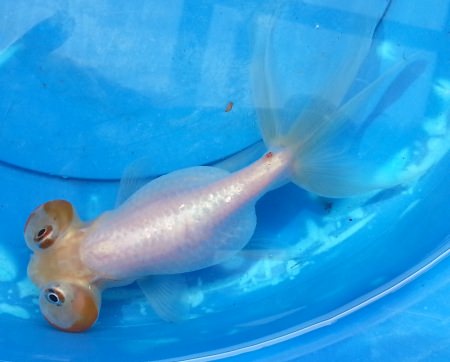| Back to Back Issues Page |
 |
|
The Goldfish Gazette, Issue #095 Color Changes November 29, 2021 |
Goldfish Care TipsA Free Monthly Resource For Goldfish Enthusiasts In This Issue Metallic scaled Goldfish change color early in their development, then many change color again, usually to white. Color Changes
Orange Bubble Eye changing to whiteBefore discussing why your Goldfish is changing into another color, first we need to discuss the different scale types possible. Scale type is actually a misnomer as scales themselves are translucent and colorless. It is the pigment cells and guanine in the skin that determine the color of a Goldfish.Scale TypesMetallic - The most common scale type, with the fish being a single color or two, one color being black, yellow, orange or red, the other being white. The scales are highly reflective and look like polished metal in strong sunlight. Black varieties are the exception having a satin like appearance.Any black coloration that is not the primary color of the fish, such as on a Black Moor, will be due to the fish still going through its first color change, or the fish has sustained skin damage from injury, chlorine/chloramine burns or ammonia/nitrite burns. The black color seems quite unstable, and all black fish have a high probability of the black fading away and being replaced by another color. Panda Moors are a good example of this, with most turning completely white over time. Metallic fry are a drab gray color when young, and first change to a dark color. That fades to a light yellow, beginning in the lower belly area before moving up the body and finally into the fins. The intensity of the dark color depends on light conditions the fry are kept in. Under natural light the fry will turn black. In artificial light the fry sometimes only show the faintest hint of darkening before the color starts to fade and be replaced by a light yellow, which darkens depending on lighting. Fish kept outside develop far deeper colors than those kept indoors. Metallic fish will develop more intense coloration no matter what age if moved outdoors. The most common color change for yellow, orange or red metallic fish, is to white. A sure sign the fish will ultimately change color is if there is any white present on the fish after its first color change. White areas tend to increase in size until they completely replace the original color. What triggers this change isn't known, but it is genetically linked as the more developed varieties seem more prone to changing. Matt - This scale type describes fish having a translucent or flat coloration, exactly the opposite to metallic scaled fish. There is no reflective tissue present, not even in the eye orbit which is black. There is little color, often none making the goldfish appear pink and translucent. This goldfish scale type is the least popular because of the lack of color options, and it appears to be less robust than the other types. Matt coloration seems to remain stable throughout a fish's life. Nacreous (Calico) - This scale type is a mixture of translucent and reflective tissue, giving rise to the greatest possible number of colors on a fish such as orange, red, blue, brown, black and white. This scale type also seems to remain relatively stable if fish aren’t kept in strong sunlight which tends to fade their colors. Black areas on nacreous scaled fish do not fade. The three scale types above were once the only scale types known. Today, there are four other scale types that are becoming more common, they are Mock Metallic, Blue Belly, Pseudo Matt and Colored Matt. Mock Metallic fish are single colored fish with translucent areas of the body. Over time, guanine deposits that give metallic fish their reflective appearance increase until the fish appears indistinguishable from any other uncolored metallic fish. The Blue Belly goes through a color change so there could be some color instability, but the Matts’ color stability should be similar to nacreous scaled fish. Celestial Fry Growth TestYou may remember in last month’s Gazette an experiment I am conducting with a few Celestial juveniles.I am trying to determine how fast I can grow them to 75mm, and more importantly, what their food conversion rate (FCR) is. I measured and weighed the test fish at 12 weeks and was somewhat disappointed at their size. They had increase length by just 7%, when earlier they were averaging 17%. After weighing, I saw the fish now weighed 9 grams on average, meaning I should have been increasing food up to 6 grams a day. I had only been feeding 3 grams, hence the slowdown in growth. The FCR has improved from 6.5 to 4.8. With better record keeping I expect it will improve further. The next measurements in 3 weeks from now should confirm the expected growth rate has returned. Comments? Ideas? Feedback? I'd love to hear from you. Just reply to this e-zine and tell me what you think, or what topics you want covered. Next Month's Topic Plant Sterilizingwww.facebook.com/aboutgoldfish |
| Back to Back Issues Page |
